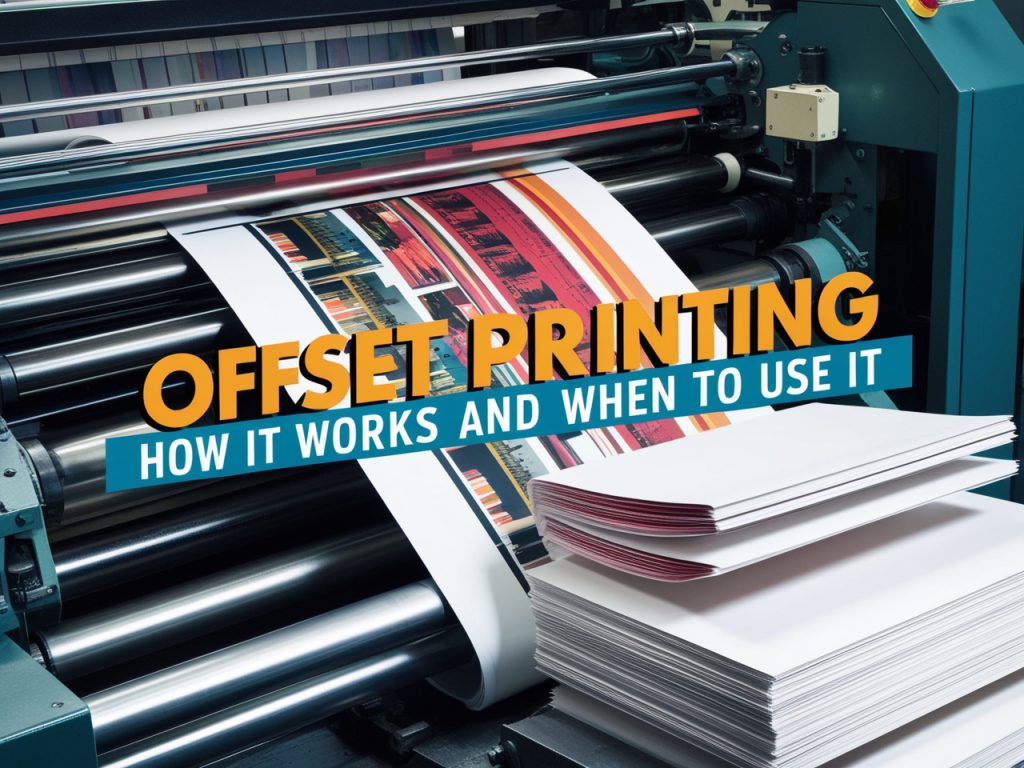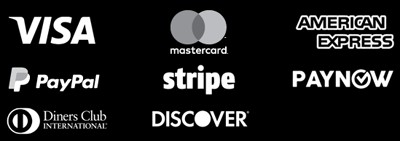
Offset printing is a traditional and highly efficient printing method, especially for high-volume jobs. It produces consistently high-quality prints and is ideal for projects requiring precise color matching, sharp details, and cost-effective bulk printing. Offset printing remains a popular choice for business cards, brochures, catalogs, magazines, and more. In this guide, we’ll explore how offset printing works, its benefits, and when you should choose offset over other printing methods like digital printing.
1. What is Offset Printing? #
Offset printing, also known as offset lithography, is a method where an inked image is transferred (or “offset”) from a metal plate to a rubber blanket and then onto the printing surface, typically paper. The use of rubber blankets makes it possible to print on a wide variety of surfaces, including paper, cardstock, and even fabric.
How Offset Printing Works: #
- Pre-Press Process:
- The design is prepared and separated into four primary colors (Cyan, Magenta, Yellow, and Black, known as CMYK).
- Each color gets its own printing plate. These plates are created through a process called plate making, where the image or text is etched or digitally burned onto the metal plates.
- Inking Process:
- The printing plates are coated with ink, and the non-image areas repel the ink, while the image areas retain it.
- Transferring the Image:
- The inked image from the plate is transferred onto a rubber blanket cylinder. The rubber blanket then presses the ink onto the paper (or another substrate).
- Printing:
- The paper passes between the rubber blanket and an impression cylinder, receiving the inked image. This process can be repeated several times for multi-colored prints.
Key Feature: #
- Indirect Transfer: The ink is not applied directly from the plate to the paper; it first goes to a rubber blanket, which ensures a smoother, more even distribution of ink and reduces wear on the plate.
2. Advantages of Offset Printing #
Offset printing offers several advantages over digital printing, especially when dealing with high-volume projects or jobs that require specialty finishes.
1. High-Quality and Consistent Prints #
- Why It’s Important: Offset printing delivers superior print quality with sharp images and consistent colors across all prints, even in large runs. The use of high-resolution printing plates ensures clean, detailed reproductions.
- Best For: High-end brochures, magazines, catalogs, and marketing materials where image quality and consistency are essential.
2. Cost-Effective for Large Runs #
- Why It’s Important: While offset printing has higher initial setup costs due to plate making, the cost per unit decreases significantly with larger print runs. This makes it more economical for high-volume orders compared to digital printing.
- Best For: Bulk printing projects like large quantities of business cards, posters, or flyers.
3. Accurate Color Reproduction #
- Why It’s Important: Offset printing uses the CMYK color process and can also accommodate Pantone spot colors for precise color matching. This is essential for businesses that require exact brand colors in their print materials.
- Best For: Branding materials where color consistency and matching are crucial, such as logos and packaging.
4. Variety of Paper and Ink Options #
- Why It’s Important: Offset printing works well on a wide range of paper stocks, including textured, coated, and uncoated paper. It also allows for the use of specialty inks, such as metallic or fluorescent inks, that aren’t always available in digital printing.
- Best For: Projects that require unique finishes, paper types, or specialty inks, such as luxury brochures or custom packaging.
5. Faster for Large Jobs #
- Why It’s Important: Once the initial setup is complete, offset printing can handle high-speed printing for large-volume projects. This makes it more efficient for big print runs, where digital printing might be slower and more expensive.
- Best For: Magazines, books, or catalogs with thousands of copies.
3. Offset Printing vs. Digital Printing #
While both methods have their benefits, knowing when to use offset printing versus digital printing can help you optimize both quality and cost.
Offset Printing: #
- Best For:
- High-volume jobs (typically 500+ units).
- Projects that require precise color matching (Pantone or spot colors).
- Printing on a wide variety of paper types and finishes.
- Projects that include specialty inks or finishes (metallics, foils).
- Cost Structure:
- Higher initial setup costs due to plate creation.
- Cost per unit decreases with higher print quantities, making it economical for large print runs.
Digital Printing: #
- Best For:
- Short-run jobs (typically fewer than 500 units).
- Projects that require quick turnaround times.
- Jobs that involve variable data printing (customized names, addresses).
- Cost Structure:
- No setup fees, making it ideal for small quantities.
- Cost per unit remains constant, so it’s less economical for large print runs.
Conclusion: Choose offset printing when you need high-quality, consistent prints at scale, or when your project involves custom inks or paper types. Opt for digital printing when you need short-run, fast, or personalized printing.
4. Types of Offset Printing #
Offset printing can be done in different formats depending on the size and scope of your project. Here are the main types of offset printing:
1. Sheet-Fed Offset Printing #
- How It Works: Individual sheets of paper are fed into the press, where the inked image is transferred to each sheet. This method allows for high-quality printing on a variety of paper sizes and stocks.
- Best For: Magazines, brochures, business cards, postcards, and high-end marketing materials.
- Advantages:
- Excellent color control and precision.
- Ideal for smaller to medium print runs with high-quality requirements.
- Versatility in paper types, thicknesses, and sizes.
2. Web Offset Printing #
- How It Works: Web offset printing uses large rolls of paper that are continuously fed through the press, which is faster than sheet-fed printing. This method is typically used for very large print runs.
- Best For: Newspapers, catalogs, books, and large-quantity publications.
- Advantages:
- Fast production speeds, making it ideal for high-volume jobs.
- More cost-effective for large print runs.
- Can handle continuous printing for large projects like newspapers and magazines.
3. UV Offset Printing #
- How It Works: UV offset printing uses ultraviolet (UV) light to cure inks as they are printed. This allows for faster drying times and enables printing on non-porous surfaces like plastic or metal.
- Best For: Packaging, labels, plastic cards, or materials that require a quick drying time.
- Advantages:
- Immediate drying time with no risk of smudging.
- Allows for printing on unusual materials (e.g., plastic, metal).
- Produces vibrant colors with a glossy finish.
5. When to Use Offset Printing #
1. Large Print Runs #
- Why Offset Printing Works: For projects that require hundreds or thousands of copies, offset printing becomes much more cost-effective due to the reduced cost per unit after setup.
- Best For: Large batches of brochures, magazines, catalogs, or books.
2. Projects Requiring Spot Colors or Pantone Matching #
- Why Offset Printing Works: Offset printing offers the use of Pantone spot colors, which ensures precise color matching. This is especially important for brands that require consistent colors across all printed materials.
- Best For: Branding materials like business cards, logos, packaging, and signage where color consistency is crucial.
3. Specialty Finishes or Inks #
- Why Offset Printing Works: If your project involves unique finishes such as metallic inks, embossing, or custom textures, offset printing can handle these specialty requirements.
- Best For: Premium marketing materials, high-end brochures, invitations, or product packaging.
4. High-Quality Images and Fine Detail #
- Why Offset Printing Works: Offset printing offers high-resolution printing with sharp, clean lines and vibrant colors. It’s the go-to choice for projects that require detailed images and fine text.
- Best For: Photography prints, art books, catalogs, or corporate materials with detailed visuals.
6. Cost Considerations for Offset Printing #
While offset printing is cost-effective for large print runs, it comes with initial setup costs due to the preparation of plates and the time needed to get the press ready. Here’s a breakdown of the cost structure:
Setup Costs: #
- Printing Plates: A separate plate must be made for each color in the design (CMYK and any spot colors). This contributes to higher initial costs.
- Prepress: Preparation time for setting up the printing machine, aligning plates, and ensuring the right color calibration.
Cost Per Unit: #
- Lower Costs for Large Runs: Once the plates are made and the press is set up, the cost per unit decreases significantly with larger quantities. For example, printing 1,000 brochures with offset is much cheaper per unit than printing 100.
Variable Costs: #
- Paper and Ink: Specialty papers or inks (metallic, Pantone, UV) can add to the overall cost of the project. Be sure to factor this in when deciding on paper type and finishes.
Conclusion #
Offset printing remains a top choice for businesses and organizations that need high-quality, large-volume print projects. Its ability to produce consistent colors, sharp images, and a wide range of finishes makes it ideal for catalogs, brochures, magazines, and other bulk printing needs. If your project involves specialty inks, unique paper types, or exact color matching, offset printing provides the flexibility and precision needed to meet your requirements. While it may have higher setup costs, the long-term savings for large print runs make it an economical choice for many printing projects.
You can find free business card templates on Freepik.
Learn more about the different printing methods in this comprehensive guide.

